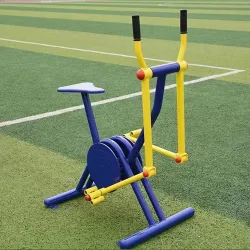Features and considerations related to public exercise equipment
2024-02-19
Public exercise equipment refers to fitness equipment that is installed in public spaces, such as parks, recreational areas, or outdoor fitness zones. These installations are designed to encourage physical activity and provide opportunities for people to engage in exercise in an accessible and community-oriented environment. Here are some common features and considerations related to public exercise equipment:
1. Types of Public Exercise Equipment:
- Outdoor Gyms: These may include various types of exercise stations such as elliptical machines, stationary bikes, pull-up bars, parallel bars, and more.
- Fitness Trails: Paths or trails equipped with exercise stations at intervals, allowing users to jog or walk between stations and perform different exercises.
- Calisthenics Parks: Dedicated areas with bars, rings, and other equipment for bodyweight exercises like pull-ups, dips, and push-ups.
- Multifunctional Stations: Some installations feature equipment that can be used for a variety of exercises, providing a versatile workout experience.
2. Benefits:
- Accessibility: Public exercise equipment is often free to use and easily accessible, making fitness opportunities available to a wide range of people regardless of income or membership fees.
- Community Engagement: These installations promote social interaction and community engagement as people gather to exercise and lead a healthier lifestyle together.
- Outdoor Enjoyment: Exercising in outdoor settings allows individuals to enjoy fresh air, sunlight, and nature while improving their fitness.
3. Installation Locations:
- Parks and Recreation Areas: Many public exercise installations are found in parks and recreational spaces, providing a natural and inviting setting.
- Urban Spaces: Some cities incorporate exercise equipment into urban areas, such as along sidewalks, trails, or plazas.
- Schools and Campuses: Educational institutions may install public exercise equipment to encourage physical activity among students and staff.
4. Maintenance:
- Public exercise equipment requires regular maintenance to ensure safety and functionality. This includes checking for wear and tear, making repairs, and keeping the equipment clean.
- Adequate signage and instructions should be provided to guide users on proper usage and safety precautions.
5. Inclusive Design:
- Consideration should be given to designing equipment that is accessible to people of various fitness levels, ages, and abilities.
- Features such as adjustable resistance levels, clear instructions, and equipment suitable for wheelchair users contribute to inclusivity.
6. Safety Measures:
- Safety is a priority, and equipment should be designed and installed to minimize the risk of injuries.
- Adequate spacing between equipment, non-slip surfaces, and durable materials are factors that contribute to safety.
Public exercise equipment serves as a valuable resource in promoting a healthy and active lifestyle within communities, fostering social interaction, and making fitness opportunities more widely available.



